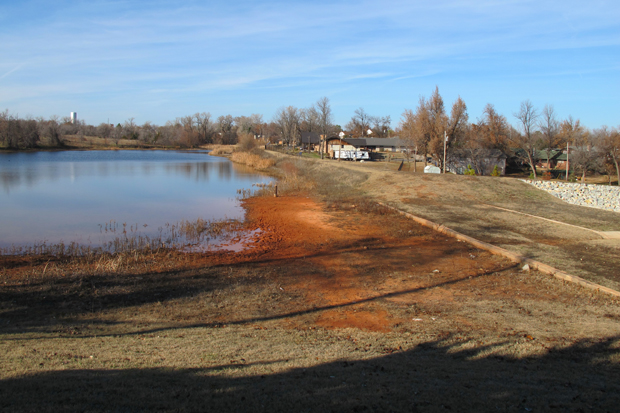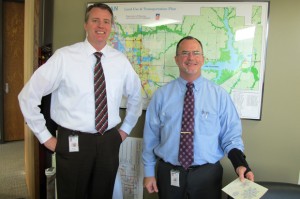
The Hall Park Dam in northeast Norman, Okla., was recently reclassified from a low hazard dam to a high hazard dam because of development behind the structure.
Logan Layden / StateImpact Oklahoma


The Hall Park Dam in northeast Norman, Okla., was recently reclassified from a low hazard dam to a high hazard dam because of development behind the structure.
Logan Layden / StateImpact Oklahoma

Joe Wertz / StateImpact Oklahoma
Families and a fisherman along the spillway beneath Broken Bow Dam in southeastern Oklahoma.
Oklahoma has nearly 5,000 dams, more than most other states. When they were built, they were classified based on the risk their failure would pose to people and property.
But for many dams, it’s been decades since that risk was evaluated, and the potential hazard has changed because Oklahoma has changed. There are houses, roads and people where there weren’t before.
How did Oklahoma get so far behind in the dam reclassification game?
Mainly, the cost. Reclassifying dams into proper categories — low, significant or high-hazard, if loss of life could result in a dam’s failure — is expensive and time consuming. The Oklahoma Water Resources Board oversees the state’s dam safety program, and Director Yohanes Sugeng is trying to meet a pressing public safety need without a lot of money.
“We have really limited resources, and so our resources, we tend to put all in high-hazard dams and significant hazard dams and kind of put low-hazard dams on the back burner a little bit,” Sugeng says.
The problem is some of those low-hazard dams would be considered high hazard today, after decades of downstream development. Oklahoma’s first dam classifications were done in the 1970s. And for many dams, that remains the only time their hazard potential was assessed.
The Association of Dam Safety Officials puts out yearly reports comparing how states handle dam safety, the latest of which shows the amount of the state budget Oklahoma directs to dam safety is a fraction of the national average. But an influx of federal money in 2009 kick-started the reclassification effort.
“So, from this we kind of found out, like wow, it’s been 20 or 30 years,” Sugeng says.
The funding meant OWRB could afford an aerial assessment of the low hazard dams, and about 600 of them didn’t look so low hazard anymore. Further mapping and site visits narrowed the total number of dams needing reclassification to about 30.
“Since that time when many of the classifications were done, there’s been more development in these areas,” the OWRB’s Cole Perryman says. “And we’ve really tried to go back since 2009 and reclassify them.”

Logan Layden / StateImpact Oklahoma
The Hall Park Dam in northeast Norman, Okla., was recently reclassified from a low hazard dam to a high hazard dam because of development behind the structure.
Dams in Oklahoma are owned by state, federal and local governments, as well as utility companies, but about half of the state’s dams are privately owned. Private dam owners are supposed to get their low hazard dams inspected every five years and report when downstream development necessitates reclassification.
“With over 4,000 dams, the response from the owners has been kind of low on that,” Sugeng says, again emphasizing the prohibitive costs associated with reclassification. “They don’t have the resources to suddenly follow our rules.”
Private dam owners have to foot the bill for upgrades if, say, their low hazard dam is reclassified as high hazard, and it can costs hundreds of thousands of dollars. Instead the OWRB has so far focused on dams owned by conservation districts and cities, like Norman, which are better able to pay for such expensive fixes.
Norman Public Works Director Shawn O’Leary says when Norman annexed the tiny community of Hall Park in the early 2000s it didn’t think much at all about the swimming hole local residents had been using since the 1940s.

Logan Layden / StateImpact Oklahoma
Norman Capital Projects Manager Scott Sturtz (left) and Public Works Director Shawn O'Leary say their city will spend more than $1 million for two dams that needed reclassification.
“Frankly, we didn’t know much about the dam. It’s something we inhered,” O’Leary says. Once he got to know it better, he noticed “a lot of problems with tree growth and lack of maintenance and the dam was I think a foot shorter than it should’ve been.”
So the city redesigned and rebuilt the Hall Park Dam, at a cost of about $300,000.
“We worked with the neighborhood — Hall Park neighborhood. Several of them weren’t very happy,” O’Leary says.
Alice Lindsay, who lives right next to the dam, is one of those unhappy neighbors. From her backyard, she describes what her view used to be like.
“All of that area, that dam right there, was covered with trees, some of them 100 years old. There was a natural stream that ran right down there. It was a beautiful area,” she says. “They came in and now we look like a gravel pit or a rock quarry out here, like the great Mississippi is gonna come through and they got to block it up.”
Norman officials would’ve rather not pulled those old trees up, or spent $300,000 dollars, but O’Leary says there was no choice. The Hall Park Dam was now high hazard, because if the worst-case scenario happened — some massive flood without the dam being upgraded — the results could be dangerous.
“The force of the additional floodwaters then causes a breach of the dam,” O’Leary says. “And of course a breach of the dam could have caused damage to properties, it could’ve flooded people, there could’ve been people harmed downstream from the dam, Robinson Street could’ve been overtopped.”
Oklahoma has used federal money to add staff to its dam safety program, and is offering free inspectors of low-hazards dams. The idea is, going forward, is for the state to avoid once again falling decades behind.